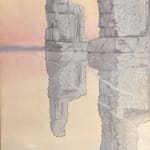William John Palmer-Jones (1887-1974)
In 1912, Palmer-Jones travelled with the Metropolitan Museum Egyptian Expedition to Luxor, drawing up plans of their excavation of the Monastery of St Epiphanius. As a trained architect, he was eager to record the towering monuments of ancient Thebes, and on his return published 'Egyptian Temples and Mosques' (1914/15), a portfolio of 20 lithographs made after his charcoal drawings from the expedition. The Colossi of Memnon, the subject of one of those lithographs, were once said to have sung at dawn and dusk:
"The nearer figure is the famous vocal statue of Memnon, which emitted a musical note at sunrise, at the commencement of the Roman Empire, after it had been broken. Scientists have explained the phenomenon as due to the sudden change of temperature, the sudden heating of the stone following upon the cold nights of Egypt, and the consequent rush of air through the porous stone [...] Each morning, when the rays of the sun struck the figure, it emitted a musical note, similar in tone to the twang of a harp string. This gave rise to the belief that it was the voice of the Greek hero, Memnon responding to the greeting of his mother, Eos. The statue was restored by the Emperor Septimus Severus in 170 AD, on which the sounds at once ceased." (The Tatler, 28 July 1915,p 29)
The Maas Gallery, 6 Duke Street, St. James's, London, SW1Y 6BN
+44 (0) 20 7930 9511 | mail@maasgallery.com
This website uses cookies
This site uses cookies to help make it more useful to you. Please contact us to find out more about our Cookie Policy.




